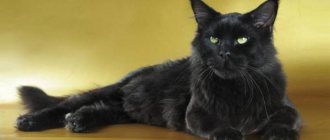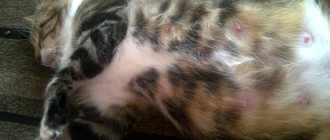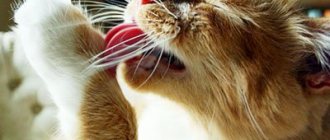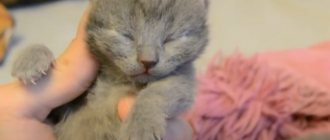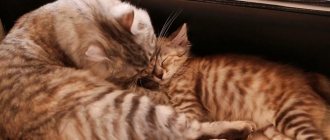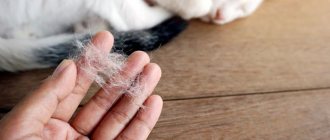What colors will the kittens from a black cat and a ginger cat be?
Cat BLACK + cat BLACK
BLACK cat + BLUE
Cats and cats - Black and Blue (but there is a possibility of chocolate, purple).
Cat BLACK + cat RED
Males - Red and Cream; cats – Tortoiseshell and Blue-cream
BLACK cat + CREAM
Males - Red and Cream; cats – Tortoiseshell and Blue-cream
BLACK cat + TORTOIE
Cats - Black , Blue , Red , Cream;
Cats - Black , Blue , Tortoiseshell , Blue-cream .
BLACK cat + BLUE-CREAM (tortoiseshell)
Males - Blue and Cream (cats repeat the color of the mother),
Cats - Blue , Blue-cream (turtles)
BLUE cat + BLACK
Cats and cats – Black and Blue
BLUE cat + BLUE
BLUE cat + RED
Males - Red and Cream , females - Tortoiseshell and Blue-cream
BLUE cat + CREAM
Males - Cream , females - Blue-cream
BLUE cat + TORTOIE
Cats - Black , Blue , Red , Cream
Cats - Black , Blue , Tortoiseshell , blue-cream
BLUE cat + BLUE-CREAM (tortoiseshell)
Males - Blue , Cream (boys repeat the color of their mother),
Cats - Blue , Blue-cream (turtles)
Cat RED + cat BLACK
Cats – Black , Blue;
Cats - Tortoiseshell and Blue-cream
Cat RED + cat BLUE
Cats – Black , Blue;
Cats - Tortoiseshell and Blue-cream
Cat RED + cat RED
(breeding red and cream cats - only in this color group)
Cat RED + cat CREAM
Males - Red and Cream;
Cats – Red , Cream
RED cat + TORTOISE
Cats - Black , Blue , Red , Cream ;
Cats - Red , Cream , Tortoiseshell , Blue-cream
RED cat + BLUE-CREAM
Cats - Black , Blue , Red , Cream ;
Cats - Red , Cream , Tortoiseshell , Blue-cream
CREAM cat + BLACK
Cats – Black , Blue ;
Cats - Tortoiseshell and Blue-cream
CREAM cat + BLUE
CREAM cat + RED
Males - Red and Cream ;
Cats – Red , Cream
CREAM cat + CREAM
CREAM cat + TORTOIE
Males - Black , Blue , Red , Cream (depending on the colors of the mother);
Cats – Red , Cream , Tortoiseshell
CREAM cat + BLUE-CREAM (tortoiseshell)
Males - Blue , Cream ;
Cats - Cream , Blue-cream (turtles)
- Select a partner with an even black color without light undercoat, white spots and hairs. When mating black cats with individuals of blue and lilac color, it should be remembered that especially light colors are dangerous because of the lightening of the undercoat in black offspring. In order to obtain good light blue colors, it is advisable to carry out breeding work, if not exclusively in blue color, at least in the group of lightened colors - lilac, cream. At the same time, lilac should not have a warm tone, and cream should not be “hot” (that is, have residual ticking). A warm tone produces “rust” in a blue color, and ticking will clog up a blue color just as much as it does a cream color. Cats with warm chocolate and lilac colors, as well as tabby colors in warm or golden tones, are undesirable for mating with black individuals, since these mating options are fraught with the appearance of reddish tones in black offspring.
Crossing two dominant white cats (WW) usually results in completely white kittens and there is a risk of them being born deaf, but if both parents are heterozygous (carriers of the gene for a different color W/w), then some will be born white, and half of the kittens will have a different color or white ones will have a colored spot on the head. And finally, if white cats are homozygous for another color (ww), then the kittens will not be white. If the genotype of the white parents is unknown from the pedigree, the mating result is unpredictable.
In this case, it is not advisable to breed white cats with white cats or white cats with bicolors, since weakened kittens are born; cats of silver color with cats of the main color (blue, black, etc.), since the color deteriorates; chocolate and lilac cats; color - points with bicolors.
The main requirement for the quality of these colors is warm tones. They go well with each other, and as more or less desirable partners we can recommend intensely red and cream cats (but without a pronounced pattern or ticking), and for chocolate and lilac tabbies - golden cats with a pattern.
When mating, lilac + lilac = lilac kittens. But in general, it is undesirable to breed such colors with each other: the quality of the coat deteriorates, the color becomes “gray” and not with a “pink” tint, and the color of the eyes becomes pale. It is better to choose blue (the carrier of purple), black.
It is better to limit breeding work to a group of colorpoints and not to use fully colored cats in matings, among which there may be carriers of genes that darken the point color.
When mating a partner of solid color with bicolors (tricolors), you can get a litter that will consist of 50% kittens of solid colors and 50% of bicolor (tricolor) kittens.
By mating two bicolors (or bicolor and tricolor), you can get a litter that will consist of approximately 50% bicolor (tricolor) kittens, 25% harlequin kittens and 25% solid-colored kittens.
When mating a solid color partner with a harlequin, you can only get bicolors and tricolors. You can never get a harlequin kitten. When mating two harlequins, you can get a litter that will consist entirely of harlequin and van kittens, as the white color accumulates.
Two primary colors
Cats come in a huge variety of coat colors, but there are only two pigments that determine coat color. Eumelanin (black) and pheomelanin (red). White is omitted because it is not a color, but the absence of color.
Any other coat color is a variation of these two pigments due to genetic mutations or modifier genes.
- Dilution : changes black to blue and red to cream, chocolate to lilac.
- Dilution Modifier : The dilution modifier changes dilution colors from blue to taupe, lilac to caramel, cream to apricot.
- White spotting gene : This creates white patches in tabby cats and can range from a few hairs to almost the entire coat. So if you ever see a cat that is a mix of solid or tabby and white (no matter how big or small), the cat carries the white spotting gene. The genome responsible for white spotting in the domestic cat has not yet been determined. Cats with large white spots typically have two copies of the white spot gene.
- Dominant White : This dominant gene masks all other colors, regardless of which color genes are present.
- Albino : complete lack of pigmentation in hair, skin and eyes due to a mutation in the gene encoding tyrosinase. Tyrosine is necessary for the production of melanin, the main pigment of the skin and hair of cats; it gives us wonderful colors.
- Partial albino : This unusual coat pattern is most often found in Siamese cats, and other spiky cats have a defective form of tyrosine that does not function at normal body temperature. Genetically, the Seal Point Siamese is a black cat, but due to a tyrosine defect, pigmentation may only appear on cooler areas of the body such as the nose, ears, feet and tail.
Determining the color of the future kitten
Sooner or later, people involved in cat breeding are faced with the problem of how to find out the color of future kittens and how to control it. In this article I will talk about the genetics of the red color of cats.
I will tell you about how the red color of cats appears, from which cats with cats you can predict the appearance of red kittens and why there are practically no red cats.
Cat colors
First of all, let’s tell you a little about genetics (full information: genetics of cat colors), so that later it will be more clear how red cats appear. For now, we will not take into account such factors as the pattern of cats (spots, marbles, stripes), uniform coloring of each hair, white inclusions and other features that may affect the color of cats. Now we will talk about 2 main colors “red” - “not red” (the gene responsible for their manifestation is called “orange” (English)). For ease of understanding, let’s assume that “red” is cream and red, “not red” is blue, black, lilac and chocolate (in the future we will call them all “black”), and “tortoiseshell” is chocolate-colored. red, blue-cream, black-red and lilac-cream colors.
Genetics of colors
Now let's talk about genetics. A cat has 2 sex chromosomes “XX”, a cat has another one – “XY”. The “orange” color gene is located on the “X” chromosome, because it is larger in size; there is not enough space for this gene on the “Y” chromosome. This is why in a cat both “X” chromosomes form the color of the cat (“red” - “not red”), and as a result of which the cat is completely “red” (when its “X” chromosomes contain the “orange” gene), or completely “ black" (when its "X" chromosomes contain the "non-orange" gene), or tortoiseshell, when one of the cat's "X" chromosomes contains the "orange" gene, and the second contains the "non-orange" gene). Cats have only one “X” chromosome (the second is “Y”), so a cat can be EITHER “red” OR “black”. If the cat is “tortoiseshell” (which is very rare), then it is most likely sterile, because instead of two, it may have THREE “XXY” sex chromosomes. A kitten always receives one chromosome from both a cat and a male cat. Thus, the cat always gives the kitten one of its "X" chromosomes, and the cat gives either an "X" chromosome (and the kitten is born a cat) or a "Y" chromosome (then a cat is born). From which it follows that a cat kitten receives two sets of color (from mom and dad on the “X” chromosome), and a cat kitten receives color from mom (one “X”), and the male sex (without color) - from dad ( one "U").
Determining the color of the future kitten
1) If your cat is red and the cat is also red, then the color of all kittens will be red (both cats and males). 2) If you breed your cat with a black cat, then the kittens will all be born tortoiseshell, and the male cats will be red. 3) If a black cat was bred with a black cat, then absolutely all kittens will be black. 4) And if a black cat went on a spree with a red cat, then the cats will all appear tortoiseshell, and the cats will be black. No matter how much you want it, there will be no red kittens from this union. 5) A very interesting fact: when your cat is tortoiseshell, such a cat can give birth to kittens of any color. — From a black cat, her daughters will be black and tortoiseshell (but not red), and her sons will be red and black. - But from a red cat she will give birth to red and tortoiseshell cats (but not black), and red and black male cats. It should be remembered that in all examples lightened variations are also implied (red = cream, and black = blue, brown and purple). Now it will be much easier for you to determine the color of future kittens. You can determine the likelihood of your cat giving birth to red kittens, and also, knowing what color the cat was, you can most likely calculate the expected sex of the newborn kitten based on its color.
Kittens can have different fathers
As if the genetics of coat color weren't confusing enough, a litter of kittens can have more than one father, as a female in heat will mate with more than one male if given the opportunity. This is called superfecundation.
It is not surprising that kittens in a litter can have different coat colors among dominant genes, modifier genes, white spots and different fathers.
Determining the potential color of kittens will be used to minimize some knowledge of genetics, test matings and, with modern advances, DNA tests to determine what color coat the cat has and whether it has recessive genes.
What color will the kittens be if the cat is gray with stripes and the cat is white?
I know for sure that if the kitten is a boy, then it will be exactly the same color as the mother, and if the kitten is a girl, then her color will be the result of a mixture of the colors of the mother and father. But in your case, I can’t say for sure which gene will win: white or agouti (striped). In the case of mating with a dark cat, agouti is the dominant gene. But with white. It's not entirely clear here. It is quite possible that female kittens can take on a white color with a fuzzy dark pattern or dark spots. But I don’t exclude the possibility of an almost completely white color. Although, it seems to me, this percentage is still not large.
I'm not a geneticist. As I already said, I have little faith in the possibility of obtaining a pure white color, although I do not exclude such a possibility. I wrote everything I know about in the answer. And for more detailed instructions, I advise you to contact the breeders. - 4 years ago
A completely white kitten can only be born if one of the parents is completely white. That is, in order to be completely white, a kitten must receive the completely white gene from its completely white parent. Siamese kittens are also born completely white, but after a couple of months the Siamese color gene appears. There is such a science as genetics, everything in it is as clear as in mathematics. - 4 years ago
Hmm.. Does my answer at least somehow reflect my attitude towards animals? What's the point of your last comment if it has nothing to do with him?
It’s better for you to justify your disadvantage than to think about some breeding specialists, of whom I am not one of them. - 4 years ago
My cat Muska was similar to yours, her kittens were mostly similar to her, but in each litter there were also white beauties. The only thing is that every white kitten must have at least
Source
Color calculator
Dear breeders!
Before writing the colors of kittens, please THINK and CHECK whether you can get such colors according to the rules of genetics!
If you are still “swimming” in the genetics of colors, you can quickly calculate colors on our online cat color calculator
Also read these articles on the club website:
Calculation of kitten colors on-line:
All members of our club comply with the rules for keeping and breeding cats in force in the international felinological system WCF." Before deciding to join the club, please carefully read the rules by which we work:
• More details»
You can view the readiness of the documents you ordered here:
Non-resident breeders can track postal items here:
On-line application forms for club members and animal owners registered in the MFC "AK BARS":
Dear breeders and owners!
If you want the club to receive your information in a timely manner and to correctly and quickly complete all the necessary documents for you, please fill out the on-line forms very carefully and accurately! Nonresidents - do not forget to indicate your postal code.
On-line applications that are not filled out completely or properly will NOT be accepted and no registration actions will be taken on them!
Source
Scottish Straight (Scottish Straight cat)
Gentle, sweet, so fluffy and very charming, the Scottish Straight cat is a dream for many pet lovers.
Do you want to know in more detail who a Scottish cat is : what are the features of its external and internal qualities, what differences does its standard have, how to care for it? Then you are where you need to be.
History of the origin of the breed
The Scottish Straight has recently become an independent breed. This is due to the fact that Scottish Straight kittens are “children” of the Scottish Fold cat, which (once they reach the age of one month) have straight ears.
This division of the breed became necessary, since for the normal health of cats of this breed (without mutations that are typical when crossing two fold-eared individuals), it is necessary to cross a fold-eared cat with a straight-eared cat. Therefore, these animals were recognized as a separate breed - the Scottish Straight.
Description of the breed
The Scottish Straight cat has some features that are unique to him. If we compare this breed with the “British” (with which it is often confused), we can identify such characteristic features of the Scots as:
The life expectancy of a Scottish cat depends on: health, feeding, habitat, living conditions, etc. A more detailed description of the cat presents its breed standard, by which you can understand what a real Scottish Straight looks like.
External features and character
Scottish cats are very smart and sweet. They have a rather flexible and modest character, not requiring excessive attention to their person. They have a rather calm character. They are especially attached to one of the family members, but do not deprive others of their attention. Scottish cats do not really like to sit on their hands, preferring
Source
Color calculator
The basis for calculating the possible colors of future kittens is the Punnett table compiled on the basis of the genotypes of the father and mother cats. Many cat owners continue to fill it out manually. But these days, when the processor on a smartphone is hundreds of thousands of times more powerful than the one installed on the Apollo spacecraft that landed astronauts on the Moon, this can be done much faster and without much effort.
By clicking the mouse in the appropriate cells and noting the characteristics of the colors of the parents, in a second on the screen you will have information about the probability in % of the birth of kittens of all possible variants of the main colors.
Let's get acquainted with the popular belief - the cat itself came into the house
Signs about cats in folklore and beliefs arose quite a long time ago. This probably happened at the very moment when pets appeared in people’s lives and began to live with them. And it should be noted that superstitions are similar to each other, regardless of the country in which they originated. However, opposite meanings can also occur. In this review it is worth talking about what to expect if the cat came into the house on its own, as well as other signs.
Fateful predictions
Since ancient times, the cat, through its behavior, predicted a variety of events that could happen in a person’s life. They may turn out to be negative if a black pet crosses the road, or positive if the animal begins to wash itself. In the first case, you should expect troubles, in the second - long-awaited guests.
You may encounter other signs in which cats are the main characters. For example, if a kitten reaches out to its owner, you should expect new acquisitions. Successful completion of the case will be marked by significant benefits.
Did a cat sneeze next to a young couple? The symbol foreshadows an imminent wedding. However, sneezing can also symbolize rain with a possible deterioration in the owner’s health. If a cat strays, a cat comes to your home - good luck will come with the animal. Be sure to shelter your pet and caress it.
Happiness or misfortune?
Not all signs involving a pet can be pleasant. For example, if you hit a cat, an accident will occur. There is a high risk of injury. If the cat was killed intentionally, there will be no happiness in life for seven years.
The cat came into the house and lay down on the table? What is this for? Soon you will receive news from loved ones. The pet is lying down on its chest - it will be possible to cope with serious pain
Source
Kotovasiya Online magazine about pets
What types of British cats are there - all colors in pictures
Many of them have existed since the appearance of the breed, and some were obtained more recently as a result of careful selection.
Solid colors
In chocolate Britons, the color of the nose is slightly darker than the coat or matches its color, while in cinnamon, on the contrary , the pinkish-brown nose stands out against the background of the darker coat.
Cats of the Fawn (also called the color of a young fawn) have fur of a warm light beige shade, and the pads of their paws and nose are a delicate pinkish color.
Tortoiseshell colors
This can be a combination of rich colors (black, chocolate or cinnamon) with red, as well as blue (or purple) with cream.
The paw pads are pink or black, and the eyes are copper and gold shades. Cream slippers on the paws or short stripes on the nose are possible.
Color point color
A characteristic feature of this group of colors is a light body color and contrasting dark areas - the muzzle, ears, paws and tail.
Bicolor colors
Tabby colors
Dark stripes stretch along the back all the way to the tail, on the sides there are patterns in the form of curls, the tail and neck are decorated with rings. Colors of this type include marbled on gold and silver, as well as black marbled.
Tiger Tabby (also known as Tabby or "Mackerel") - A longitudinal stripe runs along the line of the spine, from which thin stripes descend on the sides.
Spotted tabby - spots are located on the back and sides, they stand out against a light background. Their shape can be oblong, oval or round.
Sometimes the tail is also spotted or decorated with open rings.
Source
What are genes?
A gene is a small piece of DNA located on thread-like structures called chromosomes, which are made of DNA and come in matching pairs, one from the mother and one from the father. Chromosomes are present in every cell of the body. Each gene has a fixed location (loci) on the chromosome that helps determine a specific trait, such as fur length, eye color, and hair color.
Each location may contain different genes, and there is no fixed limit on the number of alternative genes that can occupy a locus. But each cat will only have two genes at a time.
© shutterstock
Why can't a gray cat have a red kitten?
My cats constantly walk with a ginger cat, but only bring gray and black kittens. Are “Ryzhiki” really only born to calico cats?
Your cats probably have stronger genes. There was a gray cat at our local dispensary. She brought completely different kittens. It seemed like they were both red-haired and Siamese. Yes, it was a mixture of Siamese and Persian kitten. He was the most beautiful and fastest. Or maybe your cats hang out with red cats and love others?
There is no gray color in cats, there is a blue color. Blue color is a gray shade of fur, pure and uniform, without shades or hairs of a different color. The nose and paw pads are bluish-gray. Eye color is orange, copper, yellow or green.
Now about breeding and color. The blue color is a lightening, therefore a recessive color. From a blue cat you can get both red (red does not exist, it is called red) and cream cats.
If you breed a blue cat with a red cat, you will get red and cream cats and blue cream and tortoiseshell cats. To get both female cats and kittens of a red (red) color, you need the cat and male cat to be red in color. The birth of red male kittens is also possible from a tortoiseshell or blue-cream cat.
I think you're just unlucky. I had a gray cat (with a bluish tint), she first walked with a neighbor’s black cat, the kittens turned out to be gray, red, cream and black. Then she had a red-haired boyfriend, kittens began to appear of all colors and even spotted ones, although both the cat and the male cat were the same color. So you just need to keep trying, there will be red ones in some of the litters. It’s impossible for the genes of red cats not to manifest themselves at all. Or you need to choose an older cat - I read somewhere that a cat must be older than 3 years for its genes to become predominant in the offspring.
Source
How to name a gray kitten girl
A gray cat girl can be called by an affectionate and gentle name
Any gray kitten is cute and pretty, and especially if it is a girl, you want to give her some special name that will suit only her, will be beautiful and original. But in any case, you need to choose a nickname for a little gray girl, understanding that someday she will grow into a big and adult cat.
Before giving a name to a gray kitten, you need to decide what her character and habits are, and only then choose a nickname, and it should not be long enough, because it will have to be used quite often.
If, when choosing a name for a girl kitten, you are guided directly by the color of the coat, then you can choose from the following:
If you pay attention to the cat breed when choosing a nickname, then you can consider these options:
If you don’t want to stand out because of the originality of the name and want to give it a regular cat nickname, you can pay attention to the following:
You can choose any name for your little new pet, but it's best to choose names that reflect their personality and are always easy to say.
Colors of British cats with photos and descriptions
Cats with aristocratic roots were bred in Great Britain and to this day are the pride of the country. Large and medium-sized Murkies with short plush fur and a charming “Cheshire” smile are a British breed that officially appeared in 1987 and has won millions of fans. The first officially recognized representative was pure white. The desire to breed a large, strong, hardy, calm and intelligent cat has led to the fact that the colors of British cats include more than 25 species. Some of them are considered very rare and are highly valued not only in breed, but also in monetary terms.
Types and colors of British cats
Intensive work to popularize British cats, attracting other popular breeds to breed, and obtaining offspring from cats from different continents has led to the expansion of breed species. The first Britons had a thick undercoat and short coat. The relationship with the Persian cat gave birth to the British semi-longhair.
Associatively, a British cat appears to be smoky or blue in color; many “cat lovers” cannot even imagine what colors British cats come in and how unusual kittens can appear in a family of two “standard” parents. The types of colors of British cats are divided into groups depending on the pattern, the predominance of color and the method of pigmentation.
The standard color of the breed, popularly called gray or classic. The British Blue's coat is monochromatic, without light hairs; the undercoat may be slightly lighter. The skin is exclusively blue. Representatives with a lighter tone are more valuable for the breed. Kittens are allowed to have a residual pattern, which disappears as the animal grows.
№1. It is widely believed that
What color will a gray cat's kittens be?
Dear visitor, if you notice any error or inaccuracy in the operation of our website, write to us at [email protected] uz. Or use the feedback form. We will correct all inaccuracies and errors in the coming days. Thank you!
Sooner or later, people involved in cat breeding are faced with the problem of how to find out the color of future kittens and how to control it. In this article I will talk about the genetics of the red color of cats.
I will tell you about how the red color of cats appears, from which cats with cats you can predict the appearance of red kittens and why there are practically no red cats.
First of all, we’ll tell you a little about genetics (full information: genetics of cat colors), so that later it will be more clear how red cats appear. For now, we will not take into account such factors as the pattern of cats (spots, marbles, stripes), uniform coloring of each hair, white inclusions and other features that may affect the color of cats. Now we will talk about 2 main colors “red” - “not red” (the gene responsible for their manifestation is called “orange” (English)). For ease of understanding, let’s assume that “red” is cream and red, “not red” is blue, black, lilac and chocolate (in the future we will call them all “black”), and “tortoiseshell” is chocolate-colored. red, blue-cream, black-red and lilac-cream colors.
Now let's talk about genetics. A cat has 2 sex chromosomes “XX”, a cat has another one – “XY”. The “orange” color gene is located on the “X” chromosome, because it is larger in size; there is not enough space for this gene on the “Y” chromosome. This is why in a cat both “X” chromosomes form the color of the cat (“red” - “not red”), and as a result of which the cat is completely “red” (when its “X” chromosomes contain the “orange” gene), or completely “ black" (when its "X" chromosomes contain the "non-orange" gene), or tortoiseshell, when one of the "X" chromosomes
Source
Blog about British cats Everything you wanted to know about British cats and more...
Helpful information
FEDERAL LAW “On the Responsible Treatment of Animals”
On December 19, 2022, State Duma deputies adopted in the third reading a bill on the responsible treatment of animals, which introduces many prohibitions and imposes various responsibilities on Russians. The bill was introduced into parliament back in 2010, and eight years later it was considered on an expedited basis. Download file with the full text of the law here"
Website update, access to the website management system for members of the AK BARS club
Dear members of the AK BARS club!
The club's website has been updated, now our club members have the opportunity to INDEPENDENTLY log into the site management system with their username and password, and upload, update and edit their content on the site - in the sections: KENITIES, KITTENS, GALLERY, PRODUCERS, IN GOOD HANDS.
Having gained access to the site management system, you will be able to post, edit and update on the site YOURSELF:
- OWN advertisements for the sale of kittens (KITTENS section);
- information about YOUR nursery (section NURSELS);
- information about YOUR stud cats open for mating and cats (section MANUFACTURERS);
- create YOUR OWN sections and photo albums in the GALLERY of the site and upload any number of photos there;
- place advertisements for the installation of former manufacturers in the IN GOOD HANDS section.
FOR MEMBERS OF THE AK BARS CLUB - posting information on the club website is FREE, subject to filling out YOUR OWN sections INDEPENDENTLY.
To gain access you need to fill out and submit an online application:
Instructions for site users - how to fill out the site fields intended for content (upload text, photos, videos, flash animation, etc.)
Instructions for site users - how to create your own sections in the GALLERY, add albums and upload photos.
Instructions for site users - how to add information to the KITTENS section
About the vet again. certificate form-1
For those who often go to exhibitions and are faced with a refusal at the veterinary clinic to register a route there and back within the Russian Federation! Come here.
If you decide to give your cat to a shelter
What does a cat experience when it is taken to a shelter?
FeLV - feline leukemia. Feline Leukemia Virus and Lymphoma, Lymphosarcoma. How is this connected and what is it?
Buyer: how to choose a kitten
Cat genetics for dummies
For those who are too lazy to learn genetics - a quick way to calculate the colors of future kittens
WCF Show Classes, WCF Titles, Title Closing Rules
Source
Basic rules of cat genetics
2. Only the parents' colors determine the color of the kitten. The colors of other cats present in the pedigree do not have a direct effect on the color of the kitten;
5. To produce a genetically red or genetically cream-colored cat kitten in the litter, it is necessary that the father be genetically red or genetically cream, and the mother must also have a red or cream color in her genotype;
6. Dominant characteristics (dominant colors: white, veiled, shaded, smoke, tabby, bicolor, etc.) cannot skip a generation. They cannot pass, for example, from grandfather to grandson without manifesting themselves in the father;
8. Two parents of a recessive color (cream, blue, etc.) cannot produce a kitten of a dominant color (black, red, tortoiseshell, etc.);
11. A veiled/shaded kitten must have at least one parent who is either veiled/shaded or tabby;
12. A veiled/shaded parent can produce a smoky kitten, but a smoky parent cannot produce a veiled/shaded kitten;
14. All red cats have some degree of tabby. The ability to produce tabby offspring depends on whether the red cat (or cat) is a true tabby, i.e., whether it has a tabby parent or a veiled/shaded one, or whether it is simply a red cat with an outward tabby pattern. A red tabby, unless it is a true tabby, cannot produce a tabby offspring of any other color unless it is bred to a true tabby (or a veiled/shaded one);
17. Multi-colored individuals (tortie, blue-cream, tortoiseshell and white, blue-cream and white, tortoiseshell smoky, etc.) are almost always cats, but m
Source
How do a white cat and a gray cat get a red kitten? It's simple - from mom cat! And now a little more detail. The genetics of cat color are more complex than those of humans, and inheritance is more bizarre. Blonde parents can never give birth to a brunette child - such simple rules do not apply to cats. More precisely, the rules remain simple, there are simply many more “components”. The fact is that the color of cats is encoded by several genes. The appearance of a cat is determined not only by the gene responsible for the actual color of the coat, but also for the color “in general”, and for the presence (absence) and size of spots. In addition, the color gene is tightly linked to the sex chromosome. In humans, say, hair color is inherited regardless of gender. In cats, the color of the coat is inherited along with the female sex chromosome X. It turns out that a girl kitten can get color from both mom and dad, but the color of the coat of a boy kitten depends on the color of the mother cat (and her parents), i.e. e. inherited on the maternal line. First of all, the color of the coat is determined by the pair “there is color - there is no color.” The second option is true white cats - albino cats. By the way, this is a rarity, since the “color presence gene” is dominant (predominant): it alone is enough for the coat to “appear” at least some color. A true white cat can only be achieved if it inherits the “no color gene” from both parents. The second point is the color itself. In essence, there are only two main “cat” colors – black and red. Moreover, they are encoded by one gene: if it is “on”, it will turn out red, if it is turned off, it will turn out black. This particular gene is inherited only along with the X chromosome. Several interesting conclusions follow from this. Because cats only have one X chromosome, they can only inherit one variant of the gene. Consequently, the color of the cat’s fur is uniform. Cats have two X chromosomes, meaning they can inherit
Source
Genetics of cat colors in tables with comments
The colors of cats are very diverse, and therefore, for unification, a clear system of color codes was specially developed. This system allows you to quickly select the appropriate color for any cat. The material will be useful for both beginning breeders and experienced cattery owners.
In the tables below, knowing the colors of the male and female, you can determine what colors your kittens will have.
Calculation of the color of kittens from a cat and a cat of solid colors:
Calculation of the color of offspring from a male cat and a female cat of solid colors including chocolate, lilac, cinnamon and fawn in combination with red:
Calculation of the color of kittens from a pair of color-point, Burmese and Tonkinese cats:
Comments.
Cat color codes are recorded in metrics, pedigrees, in exhibition catalogs and diplomas.
This is what the color codes look like: a - blue b - chocolate c - lilac d - red e - cream f - black tortie g - blue-tortie cream tortoiseshell) h - chocolate-tortie (chocolate tortoiseshell) j - lilac-tortie (lilac tortoiseshell) n - black, seal, sable, ruddy (black, seal, sable, wild) o - sorrel, cinnamon, (sorrel, cinnamon) p — beige fawn (fawn, beige) q — sorrel cinnamon tortoiseshell (cinnamon, red-brown tortoiseshell) r — beige fawn tortie (fawn, beige tortoiseshell) s — silver, smoke (silver, smoky) w — white (white) x - unregistered (unregistered color) y - golden (golden)
Colors of British cats with photos and descriptions
Cats with aristocratic roots were bred in Great Britain and to this day are the pride of the country. Large and medium-sized Murkies with short plush fur and a charming “Cheshire” smile are a British breed that officially appeared in 1987 and has won millions of fans. The first officially recognized representative was pure white. The desire to breed a large, strong, hardy, calm and intelligent cat has led to the fact that the colors of British cats include more than 25 species. Some of them are considered very rare and are highly valued not only in breed, but also in monetary terms.
Types and colors of British cats
Intensive work to popularize British cats, attracting other popular breeds to breed, and obtaining offspring from cats from different continents has led to the expansion of breed species. The first Britons had a thick undercoat and short coat. The relationship with the Persian cat gave birth to the British semi-longhair.
Associatively, a British cat appears to be smoky or blue in color; many “cat lovers” cannot even imagine what colors British cats come in and how unusual kittens can appear in a family of two “standard” parents. The types of colors of British cats are divided into groups depending on the pattern, the predominance of color and the method of pigmentation.
The standard color of the breed, popularly called gray or classic. The British Blue's coat is monochromatic, without light hairs; the undercoat may be slightly lighter. The skin is exclusively blue. Representatives with a lighter tone are more valuable for the breed. Kittens are allowed to have a residual pattern, which disappears as the animal grows.
№1. It is widely believed that
Source
Why can't a gray cat have a red kitten?
My cats constantly walk with a ginger cat, but only bring gray and black kittens. Are “Ryzhiki” really only born to calico cats?
Your cats probably have stronger genes. There was a gray cat at our local dispensary. She brought completely different kittens. It seemed like they were both red-haired and Siamese. Yes, it was a mixture of Siamese and Persian kitten. He was the most beautiful and fastest. Or maybe your cats hang out with red cats and love others?
There is no gray color in cats, there is a blue color. Blue color is a gray shade of fur, pure and uniform, without shades or hairs of a different color. The nose and paw pads are bluish-gray. Eye color is orange, copper, yellow or green.
Now about breeding and color. The blue color is a lightening, therefore a recessive color. From a blue cat you can get both red (red does not exist, it is called red) and cream cats.
If you breed a blue cat with a red cat, you will get red and cream cats and blue cream and tortoiseshell cats. To get both female cats and kittens of a red (red) color, you need the cat and male cat to be red in color. The birth of red male kittens is also possible from a tortoiseshell or blue-cream cat.
I think you're just unlucky. I had a gray cat (with a bluish tint), she first walked with a neighbor’s black cat, the kittens turned out to be gray, red, cream and black. Then she had a red-haired boyfriend, kittens began to appear of all colors and even spotted ones, although both the cat and the male cat were the same color. So you just need to keep trying, there will be red ones in some of the litters. It’s impossible for the genes of red cats not to manifest themselves at all. Or you need to choose an older cat - I read somewhere that a cat must be older than 3 years for its genes to become predominant in the offspring.
The cat doesn’t leave my side when I feel bad, he lies on his stomach and spreads his paws so that he can
Source
A friend says that their eyes match the coat color, I have a gray (blue) kitten, the eyes are light brown (yellowish). He says that he may not be purebred, because his eyes should be gray. And it won’t be suitable for exhibitions. Is it so?
No not like this! Blue Scots should have orange eyes! A kitten's eyes change color, usually by six months. And among Scotish dogs, 80% of the score depends on the ears. cats are judged more harshly than cats. You will see your pet in all its glory by nine months, and the cat will be fully formed by two and a half years!
What is the stupidity of matching the eyes to the color of the coat?)) ) And if the cat is tortoiseshell in color. I'm afraid to imagine what kind of eyes there will be)))) There are certain rules for eye color for a certain color.
Your cat is blue, which means the eyes will be a normal color - copper, yellow or orange... Now everything is in progress, but I can already see that the eyes will not be green, blue or gray)) ) The main thing is that there is a defect in the eye color itself there were no (stains or anything else).
If the kitten has show quality (SHOW or Breeding (although mainly for breeding)), then go to the exhibition and an expert will evaluate you. As a last resort, consult a felinologist at the cat lovers club you are (or will be) a member of.
A blue cat's eyes should only be yellow-orange. Moreover, preference turns out to be a brighter and more saturated shade of orange. There can be no gray or green, this is definitely a disqual.
Please tell me, I bought a kitten of the British breed, it seems, but it didn’t seem to grow up to meet the parameters, who knows? This is how he was little and what he is now.
We are constantly adding new functionality to the main interface of the project. Unfortunately, older browsers are not able to work well with modern software products. For correct operation, use the following
When do kittens change fur and eye color?
In the first year of life, a kitten not only adapts to its environment, grows, learns, plays, but also changes the color of its eyes and fur. Just as baby teeth fall out and give way to permanent teeth, the original color and color of the eyes change over time to adult ones. We will tell you at what age it is possible to determine the color of kittens and the color of their eyes, and when the kitten’s owners should expect the beginning of such changes in the pet’s appearance.
Changing eye color
For a newborn kitten, vision does not play a significant role. Babies open their eyes between one week and 16 days. Only in the third week of life do they begin to see. Until four weeks of age, a kitten's eyes are covered with a protective film; it disappears on its own when the time comes. Small kittens usually have blue or blue-gray eyes. This is due to the fact that almost all the pigments went to forming the fur color; they have not yet really reached the eyes. In one month, when the kittens' eye color changes, it becomes noticeable that splashes of a different color have appeared in the sky-blue iris.
The less pigment, the lighter and cooler the eye shade. At the time of birth, there is still very little pigment in the iris. For this reason, all babies have cool blue or light blue eyes.
The process of changing the color of a kitten's eyes is called pre-blooming. If you want a pet with a certain eye color, choose a baby around four months old. By this point, the kitten’s eye color has changed so much that one can conclude what it will be like throughout its life. With a 50% chance you can guess what your pet's eyes will be like by looking at the eye color of its parents. Some changes in eye color are possible before the age of two. Green eye color takes longer to form than others.
You should not think that the color of a kitten's eyes is related to its color. They are directly related only in purebred cats - breeders have fixed a certain trait through selection. The main eye colors in cats are green, gold, copper, blue, blue. There are some restrictions on eye color related to belonging to a particular breed. Representatives of the Russian Blue breed have green eyes of varying color saturation. An adult Siamese cat has blue or blue eyes - here the eye color undergoes minimal changes from an early age. Ojos Azules cats have blue eyes. Ojos azules is translated from Spanish as blue eyes. These are just some examples.
There are albinos among cats. They have white fur, but their eyes can be different colors, such as blue or green.
Another feature of eye color is heterochromia, that is, one eye is different in color from the other due to the uneven distribution of pigment. Heterochromia is uncommon in cats and does not affect vitality or vision.
Changes in color
Kittens are born with fur. Babies' coats actively develop and change noticeably in texture and color in the first year of life. Kittens exchange their baby downy coat for a guard coat; already at the age of one week, the fur begins to fluff up, and the first undercoat can be seen. At five weeks, the kitten’s fur pattern becomes brighter and more contrasting, and the undercoat becomes denser. White little kittens often have a colored spot on their head, which later disappears. Felinologists advise starting to accustom your kitten to brushing as early as two and a half months. The pet still has little hair that needs to be combed. But this is the right moment to make the procedure something familiar to the kitten, a ritual of communication, and not a severe necessity.
At the age of three months, kittens have already formed a fur pattern. But it will be possible to determine the color of the kittens a little later - at six to seven months, the felinologist will be able to tell you what the pet’s color will be throughout its life. The head and ears are the main indicator; on the body the color will vary a little longer.
When a growing kitten is five months old, the color begins to change. At five to eight months, your furry friend will experience her first molt. Consult with your veterinarian which vitamins are best to give to your pet during this difficult period. Be sure to brush your pet so that he doesn't eat his own fur. By 10 months the color will be fully formed. A little later, around his first birthday, your pet will stop growing. However, up to two and a half years old, the cat is still very young, he continues to grow stronger and accumulate strength for a long, happy life.
Law of nature
When kittens change eye color, we are talking about the natural development of the pet. But a change in eye color in an adult cat indicates a possible injury or illness. Eye color may change when exposed to medications. Your pet's eyes and fur will tell you a lot about his well-being and will give an alarming signal about the need to visit a veterinarian.



